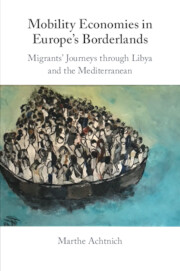43 results
5 - Stuck
- from Part II - Malta
-
- Book:
- Mobility Economies in Europe's Borderlands
- Published online:
- 12 October 2023
- Print publication:
- 26 October 2023, pp 119-148
-
- Chapter
- Export citation
Conclusion
-
- Book:
- Mobility Economies in Europe's Borderlands
- Published online:
- 12 October 2023
- Print publication:
- 26 October 2023, pp 168-175
-
- Chapter
- Export citation
6 - Moving On
- from Part II - Malta
-
- Book:
- Mobility Economies in Europe's Borderlands
- Published online:
- 12 October 2023
- Print publication:
- 26 October 2023, pp 149-167
-
- Chapter
- Export citation
Introduction
-
- Book:
- Mobility Economies in Europe's Borderlands
- Published online:
- 12 October 2023
- Print publication:
- 26 October 2023, pp 1-26
-
- Chapter
- Export citation
4 - Turbulence at Sea
-
- Book:
- Mobility Economies in Europe's Borderlands
- Published online:
- 12 October 2023
- Print publication:
- 26 October 2023, pp 104-116
-
- Chapter
- Export citation

Mobility Economies in Europe's Borderlands
- Migrants' Journeys through Libya and the Mediterranean
-
- Published online:
- 12 October 2023
- Print publication:
- 26 October 2023
19 - Investment Migration and the Importance of Due Diligence
- from Part III - Case Studies and Implications
-
-
- Book:
- Citizenship and Residence Sales
- Published online:
- 06 April 2023
- Print publication:
- 13 April 2023, pp 485-509
-
- Chapter
- Export citation
3 - A Babel and a Gehenna
- from Part II - The Nation
-
- Book:
- Foreign Jack Tars
- Published online:
- 03 November 2022
- Print publication:
- 17 November 2022, pp 83-116
-
- Chapter
- Export citation
Local Attitudes towards Postgraduate Psychiatry Training: A Maltese Perspective
-
- Journal:
- European Psychiatry / Volume 65 / Issue S1 / June 2022
- Published online by Cambridge University Press:
- 01 September 2022, p. S847
-
- Article
-
- You have access
- Open access
- Export citation
National Study on Mental Health and Emotional Wellbeing among Young People in Malta: Phase 1
-
- Journal:
- European Psychiatry / Volume 65 / Issue S1 / June 2022
- Published online by Cambridge University Press:
- 01 September 2022, pp. S596-S597
-
- Article
-
- You have access
- Open access
- Export citation
A Year of COVID-19 Pandemic Roller-Coaster: The Malta Experience, Lessons Learnt, and the Future
-
- Journal:
- Disaster Medicine and Public Health Preparedness / Volume 17 / 2023
- Published online by Cambridge University Press:
- 02 May 2022, e153
-
- Article
- Export citation
11 - Toward Neo-Universalism: Toward a New Reality in International Law?
-
- Book:
- The Treaty on the Prohibition of Nuclear Weapons
- Published online:
- 17 April 2021
- Print publication:
- 20 May 2021, pp 306-339
-
- Chapter
- Export citation

Architecture and the Senses in the Italian Renaissance
- The Varieties of Architectural Experience
-
- Published online:
- 30 April 2021
- Print publication:
- 27 May 2021
5 - Axis Ascendency
-
- Book:
- Strangling the Axis
- Published online:
- 04 June 2020
- Print publication:
- 25 June 2020, pp 107-126
-
- Chapter
- Export citation
6 - The End of the Beginning
-
- Book:
- Strangling the Axis
- Published online:
- 04 June 2020
- Print publication:
- 25 June 2020, pp 127-147
-
- Chapter
- Export citation
7 - The End in North Africa and the Shipping Crisis
-
- Book:
- Strangling the Axis
- Published online:
- 04 June 2020
- Print publication:
- 25 June 2020, pp 148-172
-
- Chapter
-
- You have access
- HTML
- Export citation
4 - Progress
-
- Book:
- Strangling the Axis
- Published online:
- 04 June 2020
- Print publication:
- 25 June 2020, pp 82-106
-
- Chapter
- Export citation
2 - Locating the British Mediterranean World
- from Part I - Mediterranean Currents
-
- Book:
- The Yellow Flag
- Published online:
- 27 March 2020
- Print publication:
- 16 April 2020, pp 48-74
-
- Chapter
- Export citation
3 - Governing Quarantine
- from Part II - Lazarettos, Health Boards, and the Building of a Biopolity
-
- Book:
- The Yellow Flag
- Published online:
- 27 March 2020
- Print publication:
- 16 April 2020, pp 77-94
-
- Chapter
- Export citation




